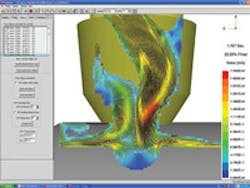Top New Functions in Simulation: Better Quality Films
The objective of casting simulation is to use computer science to design a casting process — before expensive patterns are made, before the patterns are used to form molds, and before the molds are used to shape molten metal, only to find that the castings must be scrapped because of some unforeseen defect in the process. However traditional, that approach requires making changes and producing castings again (and again) until the desired quality is achieved.
Foundries that use simulation can import their customer’s 3D models and have the program determine how many risers are required, where they should be placed, what size they should be, and what size and shape to use for sprues, runners, and gates. Then, they simulate and visualize, on a computer screen, the entire process of casting the part, including pouring, solidification, and shrinkage formation.
Using this information, a foundry can fine-tune its design to produce the best casting possible, at the lowest cost. Using optimization software, the system may even redesign the process. Because simulation is based on software, new features and techniques can be implemented with that software as soon as they are developed.
One of the recent advances in the SolidCast simulation software package is the ability to produce better movies simulating metal flowing into a mold cavity. These higher-quality movies produced by SolidCast’s new Version 7 are created in the widely used WMV format.
Finite Solutions Inc. (www.finitesolutions.com), publisher of the SolidCast products, claims that the latest movie files are in fact quite compact, but the picture quality has been dramatically improved — much clearer and more vivid than was possible to display in prior versions of the software.
At the same time, iso-surface movies have been adjusted so that they are created in the background, like the other movie functions, so that a casting designer can work on other tasks while the movie is being created. David Schmidt of Finite Solutions, told FM&T that “the software is under continuous development, and has been for over 20 years.”
There are several new features added to SolidCast for Version 7 including improved compiler technology that provides full compatibility with multi-processor, dual-core, and Hyperthreading technologies. Version 7 offers a 20% speed increase in meshing, view factor calculations, and shell creation functions, and a number of new utilities, as well as several that have been improved or expanded. (Several utilities have been newly documented in the version 7.0 training workbook.)
Utility changes begin with data capture (Temperature), used to create a grid of thermocouples that can track temperatures in the casting and mold. Early Fill Tilt Pour allows the user to specify a point in tilt pouring when most or all metal has filled the mold, prior to completion of the tilt. (For example, the system could be set to pour 90% of the metal during the first half [45°]) of a 90° tilt pour.)
Filter Shape creates a rectangular filter shape with specified open area as a STL file. The STL can be added to a SolidCast model to simulate metal flow through the filter. An iron property calculator calculates metallurgical conditions for heavier castings. Both property calculations and riser design functions of this utility have been completely documented in the training workbook.
Other utility changes include ladle calculations, mask material density in risers, project viewer, solidification time gradient, and simulation parameters.
